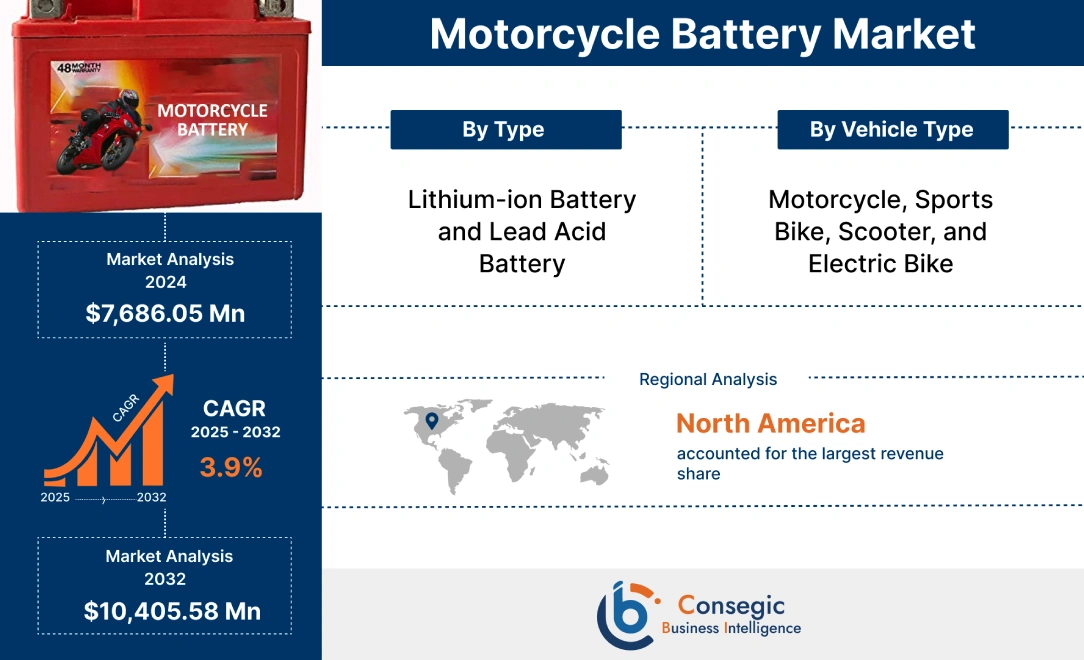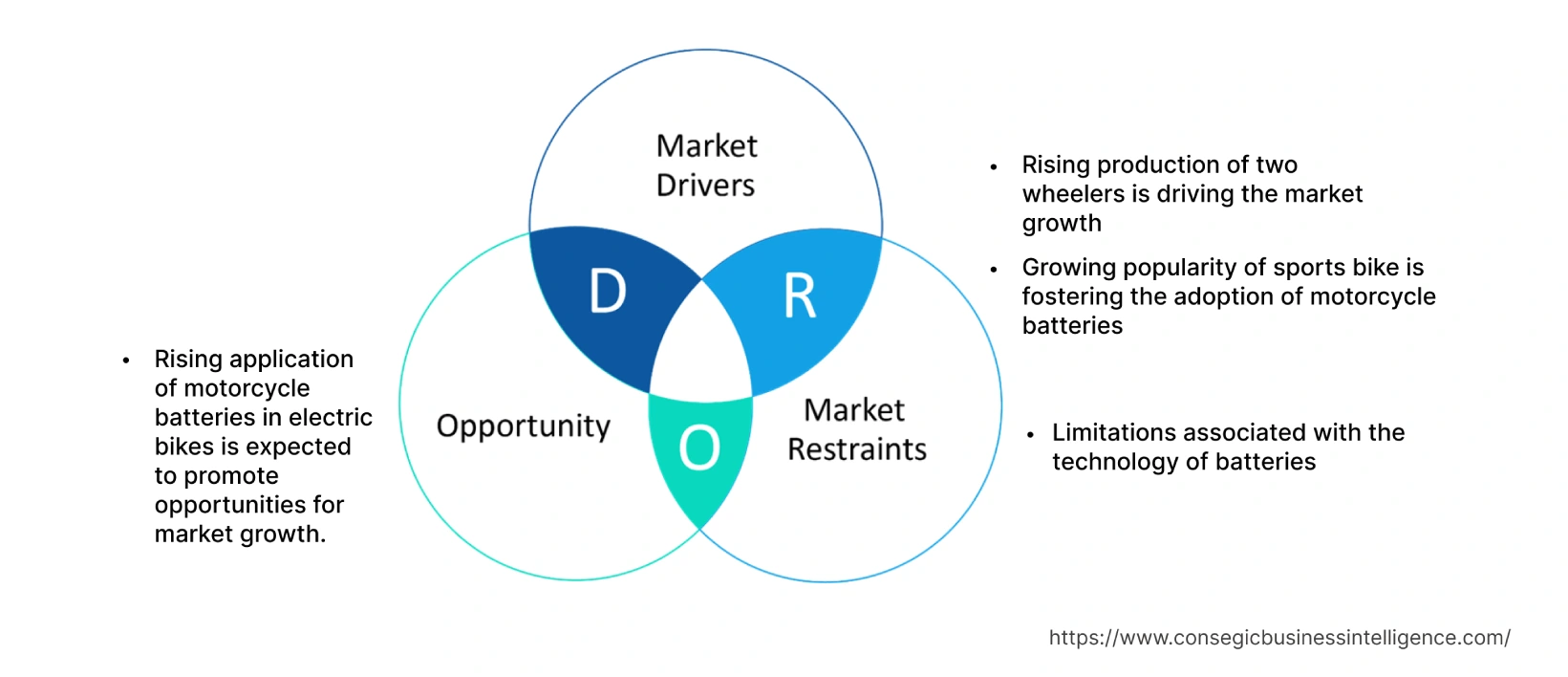Motorcycle Battery Market Market Size :
Motorcycle Battery Market size is estimated to reach over USD 10,405.58 Million by 2032 from a value of USD 7,686.05 Million in 2024 and is projected to grow by USD 7,845.78 Million in 2025, growing at a CAGR of 3.90% from 2025 to 2032.
Motorcycle Battery Market Market Scope & Overview :
A motorcycle battery refers to a device that utilizes a reversible chemical interaction between the lead and the acid in the battery for the storage of electrical energy. The primary function of a motorcycle battery includes the supply of electrical power to jump start the engine and keep the engine running. Moreover, motorcycle batteries supply electricity for operating lighting, accessories, and other electrical systems of the motorcycle during engine shutdown. The aforementioned functionalities of motorcycle batteries are key determinants for increasing its deployment in sports bikes, scooters, motorbikes, and electric bikes.
Motorcycle Battery Market Market Insights :
Motorcycle Battery Market Dynamics - (DRO) :
Key Drivers :
Rising production of two wheelers is driving the market growth
Motorcycle batteries are primarily used in two-wheeler vehicles including scooters, motorcycles, and others for storing electrical energy. Moreover, the ability of motorcycle batteries to supply electricity to start the engine and keep the engine operating makes it ideal for utilization in two-wheelers.
Factors including the rising disposable income, growing pace of urbanization, increasing traffic congestion, and rising demand for compact transportation solutions are key prospects driving the production of two-wheelers.
For instance, according to the Society of Indian Automobile Manufacturers, the total production of two-wheelers in India reached 1,94,59,009 units from April 2022 to March 2023, representing an increase of 9.2% from 1,78,21,111 units in April 2021 to March 2022. Thus, the rising production of two-wheelers is driving the adoption of motorcycle batteries, in turn driving the growth of the market.
Growing popularity of sports bike is fostering the adoption of motorcycle batteries
Sports bike has been gaining significant popularity in recent years, owing to their range of features and benefits. Sports bikes are specifically designed and optimized for acceleration, speed, braking, and cornering on asphalt concrete racetracks and roads. Moreover, sports bikes offer multiple features including higher power and torque, sleek design, and trend-setting colors, along with delivering high performance and speed. Attributing to the aforementioned features, the popularity and adoption of sports bikes are increasing, which is further driving the demand for motorcycle batteries for installation in sports bikes.
Factors including high performance, modern design, increasing bike racing events, and rising shift in consumer preference towards high power bikes are primary aspects driving the adoption of sports bikes.
For instance, according to the Motorcycle Industry Council, dual-sport bike sales in the United States increased by 18.6% in 2021 as compared to 2020. Hence, the rising adoption of sport bikes is driving the utilization of motorcycle batteries to supply electricity to start and operate the bike engine, thereby proliferating the growth of the market.
Key Restraints :
Limitations associated with the technology of batteries Restrains the Market Progress
Motorcycle batteries including lithium-ion batteries and lead acid batteries are usually associated with certain limitations, which is a prime factor restricting the growth of the market.
For instance, lithium-ion batteries are comparatively not robust with respect to some other rechargeable technologies and require incorporation of additional protection circuitry to ensure its safe operation. Moreover, lithium-ion batteries are more prone to faster ageing and have an average shelf-life of only two to three years after manufacturing. Lithium-ion batteries are also sensitive to high temperatures and relatively expensive.
Additionally, lead acid batteries have several limitations including low specific energy, slower and inefficient charging, limited usable capacity, and limited lifecycle, among others. Hence, the aforementioned limitations associated with motorcycle batteries are restraining the growth of the motorcycle battery market.
Future Opportunities :
Rising application of motorcycle batteries in electric bikes Opens New Doors
The application of motorcycle batteries in electric bikes is expected to present potential opportunities for the growth of the motorcycle battery market. Motorcycle batteries including lithium-ion batteries are often employed in electric bikes, owing to their superior performance, high energy density, and low maintenance.
Factors including the availability of a wide range of models, eco-friendliness, and the availability of tax rebates and subsidies are driving the demand for electric bikes. For instance, purchase incentives and tax benefits for electric vehicles including electric bikes are available in 21 countries listed in the European Union including Austria, Netherlands, Belgium, Spain, Poland, and other countries as of 2022. Additionally, governments across globe are adopting initiatives and framing policies to reduce pollution and increase the deployment of electric vehicles, which is further anticipated to stimulate the adoption of electric bikes. Therefore, the rising adoption of electric bikes is expected to increase the installation of motorcycle batteries in electric bikes, in turn promoting motorcycle battery market opportunities during the forecast period.
Motorcycle Battery Market Market Report Insights :
| Report Attributes | Report Details |
| Study Timeline | 2019-2032 |
| Market Size in 2032 | USD 10,405.58 Million |
| CAGR (2025-2032) | 3.9% |
| Based on the Type | Lithium-ion Battery and Lead Acid Battery |
| Based on the Vehicle Type | Motorcycle, Sports Bike, Scooter, and Electric Bike |
| Based on the Region | North America, Europe, Asia-Pacific, Latin America, and Middle East & Africa |
| Key Players | KOYO BATTERY CO. LTD, GS Yuasa International Ltd., Batterie Unibat, BS BATTERY, Leoch International Technology Limited Inc., Exide Technologies, Robert Bosch LLC, DYNAVOLT TECH Co Ltd., SF Batteries, and Johnson Controls |
Motorcycle Battery Market Segmental Analysis :
By Type :
Based on the type, the market is bifurcated into lithium-ion battery and lead acid battery. The lithium-ion battery segment accounted for the largest revenue share in the year 2024. Lithium-ion battery refers to a type of rechargeable battery that utilizes the reversible reduction of lithium ions for storing energy. Moreover, lithium-ion batteries offer several benefits including high energy density, low maintenance, better load characteristics, high performance, and the ability to handle higher charge/discharge cycles. The above benefits of lithium-ion batteries are driving their utilization in motorcycles.
In 2021, Komaki launched its new lithium-ion battery that has a range of 220 kilometers. The lithium-ion battery was developed in-house and designed for powering Komaki's new line of electric scooters. Hence, the rising developments associated with lithium-ion batteries for its utilization in motorcycles are contributing to the motorcycle battery market growth
The lead acid battery segment is anticipated to register substantial CAGR during the forecast period. A lead acid battery is a type of rechargeable battery that utilizes lead and Sulphuric acid to generate a controlled chemical reaction. The chemical reaction enables the battery to produce electricity. Additionally, as per the analysis lead acid batteries offer a range of benefits including large current capability, tolerance to overcharging, availability of various sizes, and are relatively inexpensive as compared to lithium-ion batteries. The aforementioned benefits of lead acid batteries are increasing its deployment in motorcycles.
According to the Motorcycle Industry in Europe (ACEM), registrations of new motorcycles in five of the largest European markets including Germany, France, Spain, Italy, and UK reached 226,793 units in the first three months of 2022, witnessing a rise of 14.6% as compared to the same period in 2021. Thus, based on the analysis the rising adoption of motorcycles is driving the utilization of lead-acid batteries, owing to its above-mentioned benefits, thereby driving the motorcycle battery industry during the forecast period.
By Vehicle Type:
Based on the vehicle, the market is segregated into motorcycles, sports bike, scooter, and electric bike. Motorcycle segment accounted for the largest revenue share of 51.4% in the year 2024. Factors including significant investments in the production of two-wheelers, rising disposable income, growing pace of urbanization, and increasing demand for compact mode of transportation are driving the trend of the motorcycle segment.
In January 2023, Suzuki Motor launched its GSX-8S motorcycle in the United States. The motorcycle features a parallel-twin 776cc engine along with a TFT display and full-LED lighting. Hence, the rising production of motorcycles is driving the installation of motorcycle batteries for powering the engine and other electrical components of the motorcycle. The above factors are further anticipated to drive the motorcycle battery market trend during the forecast period.
Sports bike segment is expected to witness fastest CAGR during the forecast period. According to the analysis the development of the sports bike segment is attributed to several factors including high performance, modern design, rising shift in consumer preference towards high-power bikes, and increasing bike racing events.
In May 2023, Ducati launched its new sports bike, Monster SP in India. The Monster SP is available in a dual-tone color scheme and an LED headlamp with a small fly screen up front. The bike is equipped with 4.3 inches color TFT display and powered by a 973-cc twin engine. Hence, the rising development of sports bikes is driving the adoption of motorcycle batteries for supplying electricity to start and operate the bike engine, in turn fostering market trend during the forecast period.
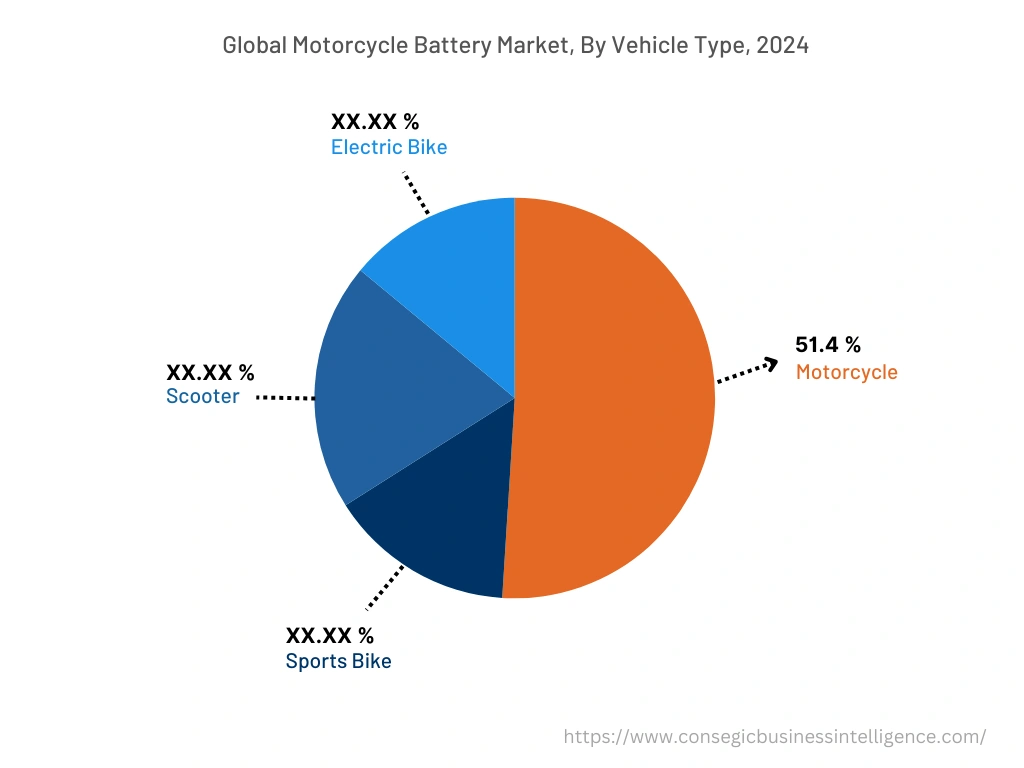
By Region :
The regional segment includes North America, Europe, Asia Pacific, Middle East and Africa, and Latin America.
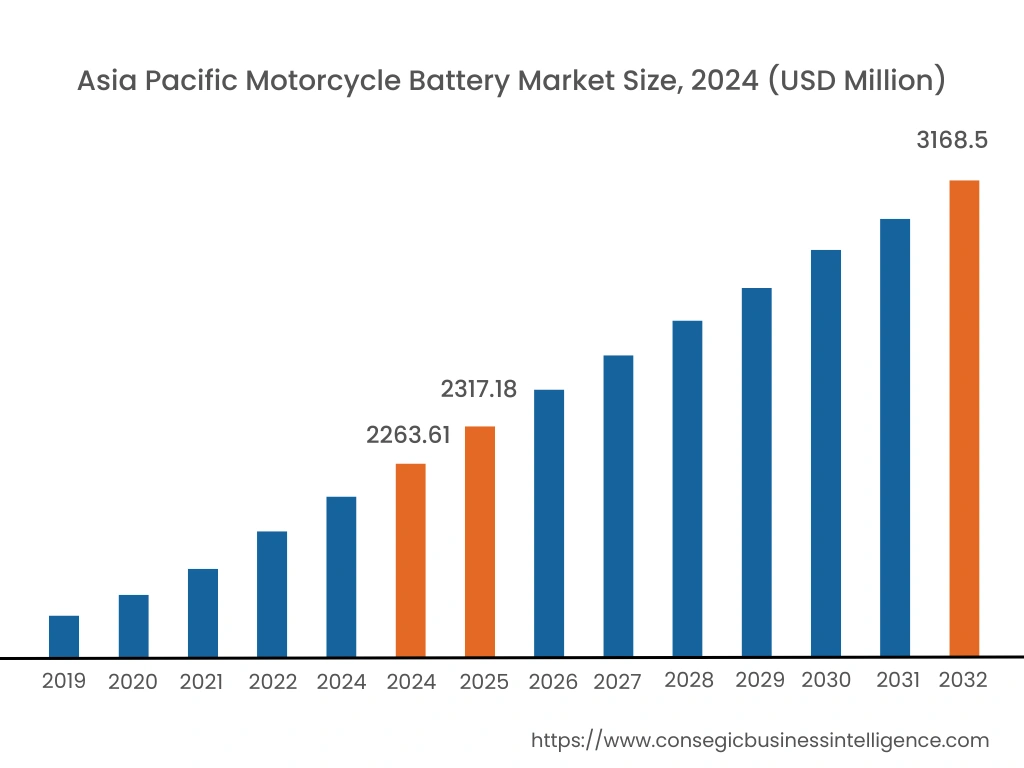
North America accounted for the largest motorcycle battery market share and is estimated to reach over USD 3,372.45 Million by 2032 from a value of USD 2,549.53 Million in 2024 and is projected to grow by USD 2,597.54 Million in 2025. Based on the motorcycle battery market analysis the development of the motorcycle battery market in North America is primarily driven by multiple factors including growing investments in the expansion of motorcycle manufacturing facilities and the rising adoption of motorcycles in the region. For instance, according to the Motorcycle & Moped Industry Council, the annual adoption of motorcycles in Canada reached 72,360 units in 2021, depicting a rise of 8.4% in comparison to 66,765 units in 2020.
Additionally, as per the analysis the rising popularity and adoption of sports bikes in the region are driving the market demand for motorcycle batteries. For instance, according to the Insurance Institute for Highway Safety (IIHS), sports bike registrations in the United States reached 431,773 units in 2021, witnessing an increase from 428,405 units in 2020. The above factors are further anticipated to drive the motorcycle battery market demand in North America during the forecast period.
Asia Pacific region was valued at USD 2,263.61 Million in 2024. Moreover, it is projected to grow by USD 2,317.18 Million in 2025 and reach over USD 3,168.50 Million by 2032, registering a CAGR of 4.1% during the forecast period. In addition, in the region, the China accounted for the maximum revenue share of 35.4% in the same year. The rapid pace of industrialization and development is fostering lucrative opportunities for market trend in the region. Moreover, as per the analysis factors including the growing pace of urbanization, rising two-wheeler production, and increasing adoption of two-wheelers for commuting purposes are stimulating market trend for motorcycle batteries in the Asia-Pacific region.
For instance, according to MotorCycles Data, the two-wheeler industry in the ASEAN countries witnessed a sales of 6.4% in 2022 as compared to 2021. Therefore, the growing adoption of two-wheelers including motorcycles, scooters, and others is driving the deployment of motorcycle batteries, thereby proliferating the market trend in the Asia-Pacific region.
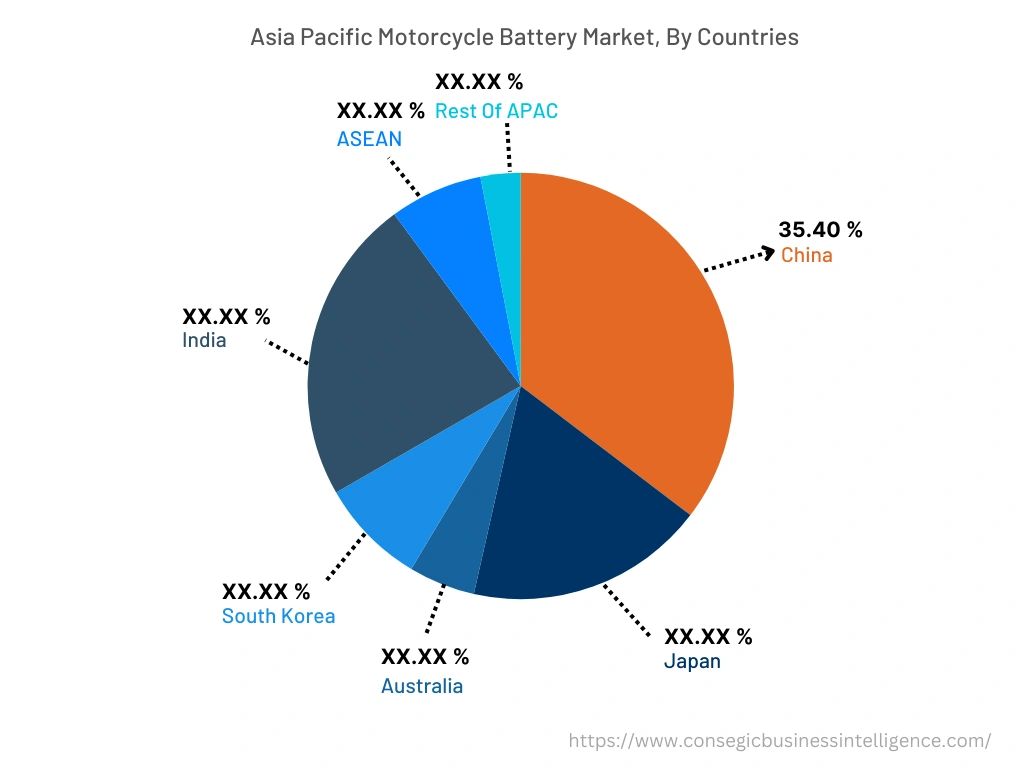
Top Key Players & Market Share Insights :
The motorcycle battery market is highly competitive with major players providing motorcycle batteries to the national and international markets. Key players are adopting several strategies in research and development (R&D), product innovation, and application launches to hold a strong position in motorcycle battery market. Key players in the motorcycle battery market include-
- KOYO BATTERY Co. Ltd.
- GS Yuasa International Ltd.
- DYNAVOLT TECH Co Ltd.
- SF Batteries
- Johnson Controls
- Batterie Unibat
- BS BATTERY
- Leoch International Technology Limited Inc.
- Exide Technologies
- Robert Bosch LLC
Recent Industry Developments :
- In January 2023, Honda and GS entered into a joint venture agreement for the development of high-capacity and high-output lithium-ion batteries, particularly for electric vehicles.
Key Questions Answered in the Report
What is motorcycle battery? +
A motorcycle battery refers to a device that utilizes a reversible chemical interaction between the lead and acid in the battery for the storage and supply of electrical energy.
What specific segmentation details are covered in the motorcycle battery report, and how is the dominating segment impacting the market growth? +
The report consists of segments including type and vehicle type. Each segment has key dominating sub-segment being driven by the industry trends and market dynamics. For instance, by type segment has witnessed lithium-ion battery as the dominating segment in the year 2024, owing to its increasing range of benefits and rising utilization in motorcycles.
What specific segmentation details are covered in the motorcycle battery market report, and how is the fastest segment anticipated to impact the market growth? +
Vehicle type segment has witnessed sports bike as the fastest-growing segment during the forecast period due to the rising adoption of motorcycle batteries in sports bike for supplying electricity to start and operate the bike engine.
Which region/country is anticipated to witness the highest CAGR during the forecast period, 2025-2032? +
Asia-Pacific is anticipated to register fastest CAGR growth during the forecast period due to rapid pace of industrialization, urbanization, and rising adoption of motorcycles for commuting purpose.
